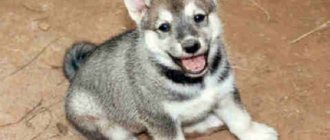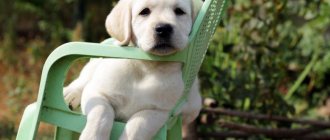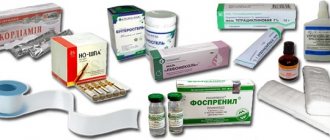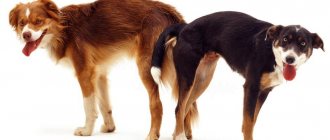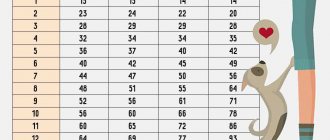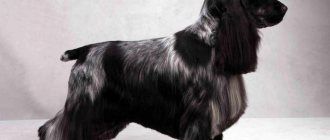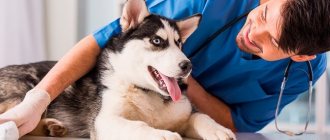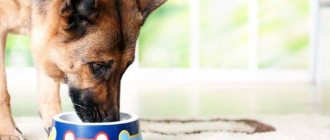Moving to a new home is a very important and exciting event in the life of a small four-legged animal. To minimize his stress, it is necessary to know at what age puppies are taken from their mother. Separation too early is detrimental not only to the psyche, but also to health.
There are also nuances regarding obtaining documents and building a show career. If you are looking for a four-legged friend, be sure to study the main stages of his growing up and the accompanying problems that he will have to face.
Physiological basis
Newborn babies are helpless and defenseless. They depend on their mother for a long time. To gain independence, they need to go through certain stages of growing up.
Stages of growing up
Four-legged pets reach physiological maturity by one year, and representatives of large breeds - only by two. Despite this, both of them go through the same stages of growing up:
- Neonatal
. Lasts the first 2 weeks. Due to blindness and deafness, babies react acutely to touch and smell. They are unable to support the weight of their body and move by crawling. Their mother is responsible for thermoregulation and feeding.
- Transition
. From the 3rd week of life, the eyes and ear canals open. Puppies learn to perceive the world around them, show their first interest in adult food, relieve themselves independently and play with their brothers and sisters.
- Socialization stage
. It begins together with the transitional period and lasts up to 1-3 years. Animals develop communication skills with other members of society and an intensified desire to study the world around them.
- Teenage
. Upon reaching six months, puberty and a period of rebellion begin.
- Youth
. Lasts up to 1-2 years. During this period, pets reach maturity and are allowed for breeding for the first time.
In most cases, the last 2 stages take place with the new family. That is, puppies are purchased even before puberty.
At what age do puppies acquire all the necessary skills?
Four-legged babies reach full independence by 2-2.5 months, when they are transferred from mother's milk to adult food. At this age they respond well to training. There are no problems with toilet training, but full-fledged walks are done only after all the required vaccinations have been completed.
Formation of immunity and administration of vaccinations
In the first 8 weeks after birth, the child's body is protected by maternal antibodies transmitted with colostrum. Gradually, passive immunity weakens and must be stimulated by vaccination.
First of all, all children are vaccinated against infectious hepatitis, leptospirosis, parainfluenza and enteritis. At 10 and 12 weeks they are vaccinated against distemper and rabies, respectively. All infections, except the last one, require revaccination, that is, re-vaccination. It is carried out 21-28 days after the main one.
“
IMPORTANT!
Vaccination too early is useless, since the immune system under maternal protection will not be able to create its own antibodies.
Spitz character
Despite the fact that Spitz dogs have a miniature and charming appearance, their character is far from the easiest. Many owners of this breed note the leadership qualities of their dogs. They are fearless and love to dominate both family members and other pets. Often, in order to attract attention, a small Spitz pounces on members of the household or barks loudly.
A disobedient animal can cause the following troubles to its owner:
- damage to furniture;
- territory label;
- aggression towards guests.
However, all character flaws of a pet directly depend on upbringing. With timely training and proper care, Spitz dogs are famous for their loyalty, obedience, and intelligence. They easily tolerate changing places. They quickly find a common language with young children. They are not capricious during walks and hygiene procedures. In addition, their small size does not prevent Spitz dogs from becoming brave defenders of their owners.
When to adopt a purebred animal
When buying a purebred pet, it is important to consider 2 points: the availability of documents and plans for the future. If you really want to, you can complete the paperwork yourself, but with exterior assessment at an early age, things are much more complicated.
Readiness of documents
The four-legged animals receive all breeding and veterinary documentation within 10-12 weeks of vaccination. This includes:
- metric, or puppy card;
- activation;
- act of mating;
- veterinary passport.
Based on the first document, a full-fledged pedigree, or certificate of origin, is obtained. This issue is usually dealt with by the owners themselves, and everything else is handled by the breeder.
If you are planning a show career
The distribution by class is given already at 2 months, but as they grow older, the appearance of the animals often changes. The most accurate estimate is given only at one year, so breeders strongly recommend not buying pets for show careers earlier than 4-6 months.
About vaccinations
A small dog is defenseless against infection. The recommended age for vaccinations is 8-12 weeks. Vaccinations for puppies according to age. Therefore, act according to the situation. If the breeder and you live in the same locality, it is wiser to take the dog, give it time to adapt, deworm it if the previous owners did not do this, and vaccinate it.
By 12 weeks you will have time to get a second immunization, allow time for the proper antibody titer to develop, and start walking your dog.
If the breeder lives far away and you have to travel, it is better not to risk it and get the puppy vaccinated. For such cases, the Nobivac Puppy vaccine is provided. The baby is vaccinated with it at 6 weeks, Nobivac DHP is given 14 days later, and puppies can be given to the breeder without fear for their own reputation. At home, after adaptation, vaccinate with biological products DHPPi + RL or analogues, which your veterinarian will recommend.
On this topic:
- How often to worm a puppy
- Deworming tablets for a puppy
Watch the video:
What is more profitable financially?
One-month and one-and-a-half-month-old babies are the cheapest, since breeders practically do not invest in feeding and vaccinating them. The disadvantages of this age include the psychological side of the issue (it is difficult to part with the mother) and a whole host of difficulties associated with the introduction of complementary foods, protecting the pet from diseases before vaccinations and obtaining a veterinary passport. It may also be difficult to determine character.
Age and independence of the puppy
You already know that a seven-week-old dog can feed itself. Find out from the breeder what he fed the puppy, try not to switch him to a different diet for two weeks. Please note that your pet needs to be fed at least four times a day. If you are at work all the time, then do not take the dog. The pet can be left for a long time from 11 weeks of age, and the feeding frequency should be three.
Buy an automatic feeder and teach your baby to eat dry granules. In this case, he can be left alone.
Please note that the puppy begins to choose a permanent place to eliminate its natural needs from the age of eight weeks. Therefore, accustom him to diapers or an absorbent mat. At this time, the pet will be in quarantine due to routine vaccination, and it is dangerous to walk it. Caring for a baby will take a lot of time. If you don't have one, get a puppy that is 11-12 weeks old or older.
Question of socialization
At 2.5-3 months, four-legged babies get along very easily with other animals and people. They do not divide them into “friends” and “strangers,” which greatly facilitates socialization. Independence and the first attempts at dominance appear at 4-6 months, so basic rules of behavior should be taught before this age.
After six months, the animal's character undergoes more and more changes. Certain behavior patterns develop that are very difficult to correct without the intervention of a dog handler.
IMPORTANT!
Timely socialization helps to avoid uncontrollable aggression and phobias.
Rules of care
In order for Spitz puppies to be active and cheerful into old age, and for their life expectancy to be more than 15 years, they need to be provided with proper care.
First of all, in their content you need to pay attention to the following points:
- Combing. Spitz dogs have quite thick fur, which requires special care. It is recommended to brush dogs twice a week using a special brush. This manipulation will help prevent fur from crumpling and remove excess fluff. However, you cannot get carried away with this procedure. Otherwise, the puppy will lose its undercoat.
- Visit to the veterinarian. The very first veterinary examination should take place when the puppy is 2 months old. In this case, the doctor will be able to assess the dog’s health and prescribe future preventive actions. Then visits to the veterinarian should be carried out at least once every six months.
- Walks. In order for small pets to spend their increased energy, but at the same time gain strength for further development, they need games in the fresh air. It is advisable to take walks at least 2 times a day, for 20-30 minutes.
When getting Spitz puppies, do not forget about precautions. Due to their increased curiosity, small pets often strive to jump from heights such as sofas, armchairs, and chests of drawers. But jumping down is very dangerous for their health. Therefore, you should not leave puppies alone.
Results: when are puppies most often taken to a new home?
After analyzing the main nuances, it becomes clear that there will still be problems. You just have to decide which of them you are willing to put up with.
Each stage has its own problems
Pets aged 1-2 months are affordable, but require a lot of care and attention. They are vulnerable to disease and are still very afraid of the world around them.
At 2-3 months, puppies are introduced to complementary foods, weaned from their mother and gradually vaccinated. They are much more suitable for independent living, but their cost will be higher due to the money invested by the breeder. Despite this, the final amount will be identical or even less than what you will have to spend on a very tiny baby.
If you are planning to pursue a show career, then it is more logical to take an older dog. Ideally, wait a year, but this risks taking longer to get used to each other and lengthy accustoming to the order in your home. For this reason, you should focus on 4-6 months, but take into account the risks with a possible change in the exterior in the future.
Small tricks
The owner of a puppy who had to distance him from his mother can use some tricks to quickly adapt. For example, it’s worth asking for something that the dog or his mother played with while at the breeder’s.
If you are purchasing a very small dog, you can place a ticking clock in a towel, wrap it on all sides and place the baby next to it. This trick will remind him of his mother's heartbeat when he was in her womb. This trick works on all breeds, be it spaniel or dachshund.
In the first days of life, the mother cares for the puppy
Thus, it is definitely very difficult to answer the question of when puppies can be distributed to new families after birth. At every stage of life, difficulties arise, so the owner should weigh the pros and cons and decide when to accept a new family member. But it is worth remembering that at any age a dog needs affection and care from its owner.
Trimming
Trimming is the process of removing dead hair to give your pet a neat appearance.
According to the standard, trimming the Pomeranian breed is allowed around the paws, on the hip, from the back, to the hocks. It is allowed to remove or trim unnecessary hair around the anus. You can also remove stray hairs around the edges of your ears.
If you go beyond the permitted haircut, you risk being fined at the exhibition.
History of the breed
Spitz are considered one of the oldest dog breeds existing on our planet. When and where these animals appeared has not yet been precisely established. However, it has been proven that Spitz dogs existed back in the Neolithic era. Often, during excavations of Stone Age pile dwellings, archaeologists found the remains of these animals.
Images of dogs of this breed are also found on artifacts of ancient Egypt, household items in the Baltic states, and stones from Lapland, Iceland, Holland, Germany and Norway.
The ancestors of the Spitz were large and medium in size. They were bred, as a rule, as shepherds and home guards.
Nowadays the variation of animals is a little different. Spitz have become much smaller in size and have acquired a more decorative appearance. This modification was caused by the work of breeders who, in the 18th century, began to improve the dog breed.
Coat
The coat of the Pomeranian Spitz breed is divided into three parts, which are:
- on the body;
- on the tail;
- on the limbs.
The coat on the body is of a double layer: the first layer is a thick undercoat, consisting of short and soft hair, the second layer is a coarse, shiny-looking coat with long guard hairs.
Wool richly covers the tail of the Pomeranian Spitz.
Beautiful and extremely thick hair covers the dog's front legs. On the upper thigh, down to the hocks, there is a long, fluffy hair that covers the remainder of the hind legs.
Number of newborns
Caring for a toy breed dog is especially important during pregnancy.
Pomeranians have long been domesticated, so the period when puppies are born is especially important for them - at this time the females are extremely vulnerable.
Spitz bear their cubs for an average of 63 - 64 days. However, you need to be careful already on day 58. A dog gives birth to one to three puppies. A dog's small body is not designed to carry more puppies.
Diet
In order for little Spitz puppies to always remain vigorous, cheerful and healthy, a proper diet is necessary.
The recommended food set should include:
- vitamins;
- proteins;
- carbohydrates;
- minerals.
You can feed your babies both dry and natural food. However, you should not combine these two different types of nutrition at one time. Otherwise, Spitz puppies may experience problems in the digestive system.
Feeding dry food
When choosing dry food, experts recommend giving preference to premium food products. As a rule, such food meets all quality standards.
Feeding with natural products
If the owner’s preference is for natural products, then some rules must be followed.
Firstly, food should always be fresh. Secondly, regularity is necessary, as well as balance.
The menu should include:
- Fermented milk products such as kefir, cottage cheese, yogurt.
- All types of meat except pork.
- Vegetables – cabbage, carrots.
- Porridge from buckwheat, rice, rolled oats.
- Fruits such as apples, pears, watermelons.
- Eggs.
- Sea fish without bones.
- Rye crackers.
Puppies should be fed strictly according to a schedule, at the same time. This approach will prevent puppies from gaining excess weight, which will negatively affect their well-being. If pets refuse food, there is no need to replace it, but it is better to wait until the animals are hungry.
Hygiene procedures
Hygiene is considered one of the most important aspects to ensure the health of dogs. Without maintaining cleanliness, puppies develop various diseases and parasites. Without hygiene procedures, dogs lose their attractive appearance, which negatively affects the results of exhibitions.
Preventative measures to keep puppies healthy:
- Bathing. Water procedures must be carried out when dogs are heavily soiled or have begun to shed. Bath pets in water at room temperature, using special shampoos for long-haired dogs.
- Teeth cleaning. It is recommended to perform oral hygiene in small puppies at least twice a week. The procedure is carried out using a special toothbrush and paste.
- Treatment of eyes and ears. This procedure is performed using a cotton pad moistened with warm boiled water. It is carried out as the eyes and ears become contaminated.
Hygiene procedures also include cutting and trimming nails. However, it is not advisable to carry out this manipulation yourself. It is better to entrust such care to specialists.
Treatment methods
Several methods are used to treat corneal dystrophy of the visual organ.
Symptomatic
For hereditary keratopathy, symptomatic treatment with ointments, drops and creams is usually prescribed. It is also recommended to take a course of multivitamins.
Attention! Conservative therapy does not stop the progression of the disease
Physiotherapeutic
Physiotherapeutic treatment of keratopathy is also a conservative method. The procedures are effective only at the early stage of the disease. At a later stage, physical therapy helps to relieve symptoms and reduce discomfort.
Keratoplasty
If other treatment methods do not bring positive results, the doctor may prescribe keratoplasty - surgery to transplant a donor cornea. There are penetrating keratoplasty, when the entire cornea is replaced, and layer-by-layer keratoplasty, when only part of the damaged area is replaced.
Photo 2. Ocular cornea after keratoplasty. There are small stitches on the operated area.
Before the operation, the patient must pass all the necessary tests and undergo special examinations. After the operation, healing medications, antibiotics and hormones are prescribed. Rehabilitation lasts up to a year. Following all doctor’s recommendations and taking prescribed medications is the most important condition for a speedy recovery.
Cross-linking
This operation strengthens the cornea, prevents further development of the disease and increases visual acuity. Cloudiness and irritation of the eye after surgery disappear very quickly.
Why loneliness is bad for dogs
Most of the bad habits of dogs (jumping on people, digging in garbage, eating excrement, aggression, excessive barking and howling) are the result of a lack of contact with the owner for a long time. When a dog is left alone in the house for too long, it loses its positive character traits and becomes less obedient.
Another negative effect of loneliness is a chronic lack of exercise. This is especially dangerous for active breeds: herding dogs, terriers, hounds and sled dogs. Deprived of the opportunity to release their energy, animals can become hyperactive, aggressive, and prone to disobedience. In the case of puppies, isolation causes permanent deficits in socialization. As a rule, this is the main reason explaining abnormal behavior in adulthood.
Remember, buying a dog is a very important step!
Yes, along with the joy of communicating with your beloved friend, you will receive a lot of worries, but these worries are pleasant if you love the animal.
The ability to take responsibility for our decisions, show care and care for the dog, overcoming some inconvenience, expending energy and our time, allows us to cultivate a strong character and a kind heart. Caring for a creature that needs our help and attention makes us stronger, wiser, purer and brighter. Buying a dog can be a great educational lesson in a child's life.
If your child asks you to buy a dog, tell him what will be required of him when caring for the dog, what share of responsibility for the animal will lie with him. Of course, children rely on our help in caring for the animal; with the advent of a dog, you will also have to put in your efforts to care for the animal. So try borrowing your friends' dog for a couple of days. Show your child in practice what it means to be responsible and care for a living being.
I'm buying a puppy! – you made this decision despite all the conditions associated with keeping a dog, having weighed all the pros and cons, then we move on. Where to start?
And you must start by choosing a place to buy.
Have you already decided on the breed you want? Read as much information as possible about the characteristics of this breed, conditions of keeping and care
Read what you should pay attention to when examining a puppy of this breed, what shortcomings and vulnerabilities there are in the health of this breed
You can go to the bird market and look at representatives of the breed that interests you. However, when you pick up the puppy you like, do not rush to tell the seller: “I’m buying a puppy!” Unfortunately, on the market there is a high probability of purchasing a sick puppy, without documents or with fake documents. The advantage of buying on the market is the cheapness and speed. You can quickly buy the puppy you like, but there is no guarantee that if you hurry, you won’t “bite your elbows” later.
Another purchasing option is online and newspaper advertisements. In this case, it is possible to come to the place and see in what conditions the puppies are kept, look at the mother dog of the puppies, evaluate her health and appearance. Be sure to ask if there are documents for the puppy and how purebred its parents are.
According to the advertisement, puppies of different quality are sold; in order to choose a really worthwhile puppy from a breeder, you need to have a good understanding of the breed. It will be difficult for a beginner not to get confused in this, so it is advisable to use the services of a professional dog handler and come to examine the puppies with him. The main thing in this matter is the reputation of the dog handler himself; he should be interested in choosing a really good puppy for you, not only to receive payment for his services, but also to maintain his good name as a good specialist. The advantage of this approach is the ability to find a good puppy at an average price, the disadvantage is that you will have to spend a lot of time searching and traveling to examine the puppies.
The most reliable place to buy truly purebred puppies is a club with a good reputation. The price in this case will be high, but the advantages are that you will receive a healthy and purebred animal with all the documents. The puppy will have good prospects for a professional career. The owner of the club will give you the necessary advice on caring for and raising your dog. It happens that at the time of your arrival there may not be puppies for sale, you will have to wait for a new litter or until the existing puppies, but still too small, grow up to move to a new home.
However, remember that the breed of an animal does not affect its ability to love its owner. Is it worth buying a puppy, because today there are many different shelters where they give non-pedigreed, but also very cute and charming puppies into good hands for free. Perhaps it is there that you will find your pet, who will give you all his love and devotion, and you will save his life!
Duration of classes
To properly educate and reinforce the desired behavior, it is necessary to take into account the age characteristics of the puppy.
From a month to a year is the period of maximum receptivity of the German Shepherd, when training is especially easy and the connection between the owner and the pet, as between the leader and the subordinate individual in the pack, is finally consolidated. But “subordinate” does not mean “lack of initiative” or “cowardly”! The German Shepherd is a full member of your human pack!
In order not to end up with a morally broken dog, when raising (socialization, games, obedience), it is necessary to take into account the individual characteristics and age of the person being trained:
- for puppies 1.5-2 months old, the duration of classes should not exceed 5-10 minutes;
- for 3 months the time can be increased by 5-7 minutes;
- from 4 months, the lesson can last up to 20 minutes;
- The duration of classes with a puppy should increase gradually, and by the age of 1 year, lessons can last up to 40 minutes.
A German Shepherd puppy develops mentally and physically according to its breed, and to force the initial training skills means to end up with a shepherd that awaits the next order with indifference or horror.
The dog, as dog experts say, will “get stuck,” and this is a serious step back, which most often leads to the complete inability of the individual to learn at an older age. The “spell” must be prevented at all costs! Be patient, over time everything will work out, and you will get the dog you dreamed of when purchasing the BUT puppy.
By raising a puppy with the help of play exercises, you instill in him the necessary skills for further training, and the exercises themselves easily fit into everyday interaction with the puppy on a walk and at home.

